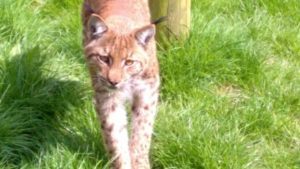
The answer is resounding “maybe.”
Even though drones have augmented animal searches, their track record so far is spotty but getting better.
Last week, a drone pilot with VSI Aerial volunteered to help find four missing horses in Mt. Airy, Maryland.
The horses had been missing for seven days and , although one horse was found, the remaining three are stilling at large.
Meanwhile in England, a lynx remains on the loose near Dartmoor even after a drone helped narrow the search, snapping a thermal still of the fleeing feline.
Two-year-old Flaviu escaped the Dartmoor Zoo on July 7 and is still hidden in the hills and valleys of the rugged countryside (the spooky setting for The Hound of the Baskervilles).
Although officials have tried everything from ocelot urine to meat traps, the cat continues to elude search parties. However, drones co-owned by the Devon and Cornwall police pinpointed the lynx’s location on the night of July 8 using thermal imaging cameras.
“In the first 32 seconds [the drone film] shows a single white thermal signature on farmland near the park. This was used to corroborate the location of the lynx as staff from the park were able to match it with marks on the ground and the behavior of the animal,” a police spokesperson said.
The mission was the first drone animal search by the departments since launching a six-month trial in February. The departments had expected to use the aircraft to look for missing persons, assist police at crime scenes and traffic accidents – although an aerial cat quest may prove just as helpful.
Although the drones have not definitively located Flaviu, the imagery has allowed searchers to establish a “human cordon” around the area the lynx had been recorded.
“Park staff set 25 humane traps baited with meat in the area,” a zoo official said. “If these have not captured the lynx, the intention is to make a human cordon of staff and police officers and move the lynx back towards the park.”
Jason is a longstanding contributor to DroneLife with an avid interest in all things tech. He focuses on anti-drone technologies and the public safety sector; police, fire, and search and rescue.
Beginning his career as a journalist in 1996, Jason has since written and edited thousands of engaging news articles, blog posts, press releases and online content.
Email Jason
TWITTER:@JasonPReagan
Subscribe to DroneLife here.